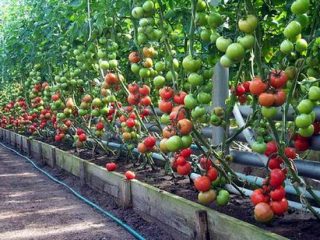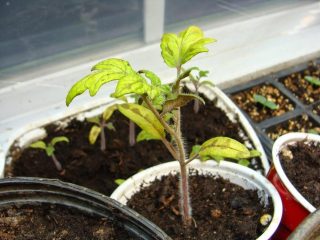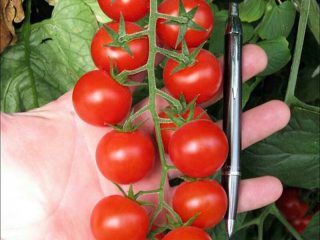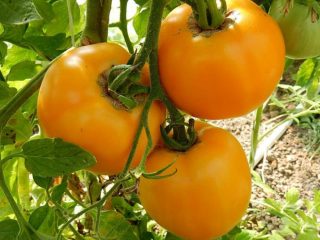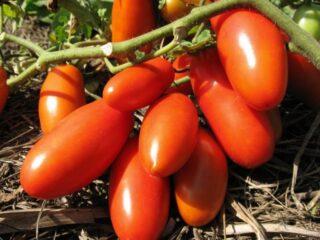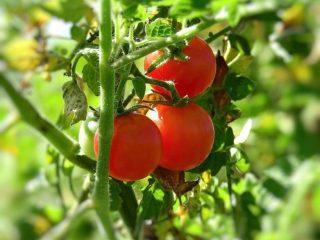Content
The Paul Robeson tomato is interesting for its unusual fruit color. At technical ripeness they are green, and when ripe they acquire a dark red hue with chocolate touches.
When and how did the variety appear?
The variety has long been known to vegetable growers. He was born back in 1930 as a result of the work of the domestic breeder Marina Danilenko.

The tomato variety is named after the famous American singer and film actor Paul Robeson
Description of the tomato variety Paul Robson
A botanical description of the variety will help you get a complete picture of the appearance of the tomato called Paul Robeson:
- The plant is classified as a semi-determinate type. It has some growth restriction, and the fruits ripen two weeks earlier than determinate varieties.
- The variety forms a tall, leafy and spreading bush. The central stem is erect, 1.2 to 1.5 m high. It is of medium thickness and therefore needs to be tied up.
- The leaf is medium-sized, juicy dark green in color with a slightly pubescent surface.
- Fruits, 3-5 pieces each, are tied and poured into flower clusters.
- Ripe tomatoes are brown in color with a green spot where the stalk attaches. The fruit size is large, the average weight is 250 grams. The shape of the tomatoes is round.
- The taste is pronounced, with a fruity aftertaste, typical of black-fruited tomatoes. The concentration of acids in tomatoes is low, but the sugar is clearly noticeable.

Under the thin skin of the tomato lies a fleshy and juicy pulp with numerous seeds.
Characteristics of tomato Paul Robeson
The varietal characteristics of a tomato determine the climatic zone of its germination, fertility and further productivity. Therefore, it is important to study the characteristics of the Paul Robeson species in order to understand the appropriateness of its choice.
Ripening and yield
Paul Robeson is classified as a mid-season variety. Tomatoes require more sunlight to ripen than early varieties. From the beginning of the growing season to harvest, 105 to 110 days pass.
This large-fruited variety is recognized as high-yielding. From one square meter you can collect from 8 to 12 kg of large fruits, but only with good care.

Tomatoes begin to bloom when they are well rooted in the ground, about four weeks after planting.
Resistance to adverse factors
This variety is resistant to adverse environmental factors. Sets fruit well. In the northern regions, Paul Robeson is grown in greenhouses, in the southern regions - in open ridges, and in the middle zone - in two ways.

Hot or cool summers have no effect on yields
Growing regions
Paul Robeson is the product of amateur selection. It was not included in the State Register of the Russian Federation. Therefore, there is no official information about admission regions and zoning. At the same time, the variety is popular and widespread in almost all regions of Russia.
Methods of application
Paul Robeson tomatoes have excellent gastronomic characteristics. The fruits are eaten fresh, ketchup, juices and adjika are prepared from them, and used in twists. Fresh tomatoes, cut into slices, look appetizing in summer salads and vegetable cuts. They taste great with cheese, herbs and other vegetables.

The round shape of tomatoes is suitable for whole-fruit canning
Advantages and disadvantages
Ripe tomatoes are marketable and suitable for sale on the market. Due to the strong skin, the fruits are well stored and transported fresh.

Tomatoes ripen quickly at room temperature
Advantages:
- resistance to diseases and pests;
- ease of care;
- good taste characteristics;
- pronounced tomato aroma;
- resistance to adverse factors.
- friendly ripening of fruits.
Flaws:
- frequent stepsoning is necessary;
- bushes need staking.
Rules and landing scheme
Tall tomatoes, such as Paul Robeson, do not take up much space on the plot. Up to seven fruit clusters grow on one stem of this variety, which allows you to harvest a good harvest without planting many bushes.

To prevent tomatoes from getting sick and producing ovaries, it is important to ensure a distance of at least half a meter between the bushes
Before planting, it is necessary to prepare the site in advance.The soil should be loose and clean, fertilized with humus and mature compost. Considering that tomatoes love soil with a neutral or slightly acidic pH (6-7), when digging the area you need to add an hour of wood ash. And as soon as the risk of return frosts has passed, seedlings can be planted in open ground.
Landing algorithm:
- Make beds 70 cm wide and form two holes on each with a distance of 50 cm.
- Water the seedlings generously so that they can be easily removed from the containers. Place the root ball in the hole.
- Slightly tilting the stem in different directions, sprinkle with garden soil. The stem needs to be deepened 10 cm from its initial level.
- Water well so that the soil settles and compacts. Mulch the bed with straw or sawdust.
After planting the seedlings, you need to tear off the lower leaves of the tomatoes. This will prevent the plant from contacting the ground. The soil contains pathogens of dangerous infections, and young plants easily catch them.
Care instructions
Plants that have successfully taken root in a new place look quite vigorous. They have already begun to build up green mass and have begun to grow. Now they need to provide quality care, which includes watering, loosening, fertilizing, as well as protection from pests and diseases.
Tomato is a southern crop. It prefers warmth, good light and moisture. Without high-quality watering, you won’t be able to enjoy a rich harvest.
Young plants are watered once every seven days, pouring one liter of warm, settled water under the stem.Adult fruiting bushes are watered once every five days, increasing the volume of liquid to 3 liters per bush.
It is important to observe the norm of watering, since a lack of moisture will lead to shedding of leaves and rotting of the fruits, and an excess will lead to a decrease in the immunity of tomatoes.

After watering, the soil must be loosened so that moisture and oxygen penetrate better to the roots.
During the growing season, the plant needs nitrogen fertilizers. And during the period of flowering and fruit formation, tomatoes need phosphorus and potassium. Superphosphate is suitable as a top dressing at the rate of one tablespoon per plant.
Pest and disease control
Paul Robeson is considered an unpretentious variety. He has a strong immune defense and rarely gets sick. However, weather conditions and errors in care lead to the occurrence of fungal diseases.
Late blight is the most common disease of tomatoes, and this variety is no exception. Fungal spores develop in conditions of high soil moisture. It appears as brown or dark brown spots on the leaves.

If control measures are not taken in time, the disease will quickly spread to neighboring plants, and the gardener will lose most of the harvest.
Fungicidal drugs help combat the disease. But after the tomato blooms, it is undesirable to use them. It is better to replace chemical compounds with a yeast solution (80 g per bucket of water).
Conclusion
Tomato Paul Robson is a large-fruited variety. It has an excellent taste and an interesting shade, which has won the hearts of many gardeners. In gratitude for good care, the plant will bring a rich harvest.
Reviews from gardeners about tomato Paul Robeson




